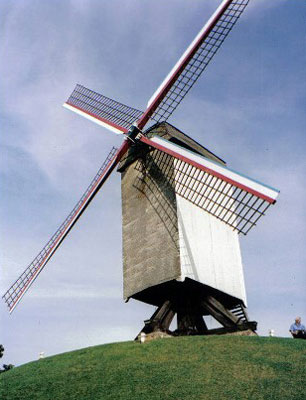 Click To Return To Main Page |
 |
||||||||
 News |
 Eco-Journalists |
 Articles |
 Games |
 Links |
 Facts 'n Fun |
 Email Us |
 About Us |
 Guestbook |
|
|
The Answer is Blowing in the Wind....
Do you ever wonder where your electricity comes from? We asked Denise Ryan, who is the Corporate Environment Manager at Integral Energy a few questions about the electricity supply in NSW. A Windfarm in Luxembourg
 Planet Patrol: How does Integral Energy make all this electricity?
Planet Patrol: How does Integral Energy make all this electricity?Denise: Well we don't exactly make the electricity, we buy it off generators and then sell it. Planet Patrol:What fossil fuels does Integral Energy use? Denise: Integral Energy is committed to sourcing a portion of our power from renewable and alternative energy projects. We are currently purchasing energy from hydro and wind generators. Also, there are advanced technology plants which use alternative energy like ‘cogeneration’ and ‘methane gas’ instead of coal. Planet Patrol:So how many ways are there to create energy? Denise: There are many ways of creating energy. Such as the wave generator. This works when ocean waves pass through it, it produces energy from the force of the waves. There are also wind turbines which are basically windmills which produce energy when a strong wind current blows the sails and turns them around. Each windfarm can produce around 1-5 hours worth of energy. Planet Patrol:Where are some of the wind farms located? Denise: Integral Energy purchases energy from a windfarm near Lithgow, which has two wind turbines (windmills). Planet Patrol:Can you tell us about 'solar in schools' Denise: Solar in Schools is a partnership between Integral Energy, the Department of Energy, Utilities and Sustainability and the NSW Department of Education and Training, to install solar panels in schools. In order to help 'Solar in Schools', Integral Energy customers can round up their bill to the nearest dollar. The extra money will go towards the 'Solar in Schools' program. Planet Patrol:Why does Integral Energy support 'Solar in Schools' the wind turbines and the wave generators even though it would mean loosing out on lots of money. Denise: Everyone here is really motivated to help our environment. Integral Energy is committed to responding to climate change and working with our customers to help the situation. Planet Patrol:Thank you Denise and good luck with the 'Solar in Schools' program. Denise:OK, Bye! Not only can you get your parents to sign-up to support the Solar in Schools program at the cost of only a few cents, but you can also get them to fill in the form on the Integral website (click the 'Community' tab) to have the Hampton Park wind farm produce either 20%, 50% or 100% of your family's electricity. If you get your parents to do this, then make sure you let us know. ...we were very young when we visited it! We were driving from Switzerland
up to Holland to visit Uncle Paul, Aunty Bea and our cousin Aidan  Here are some tips for saving electricity.
Here are some tips for saving electricity.
Remember that the less electricity you use, the less fossil fuels have to be burned. Unless we learn to use less electricity and to instead use renewable energy (electricity made by wind, water or the sun) then eventually we'll have no fossil fuels left to burn. As you can see, the idea of windfarms isn't really new;
the Dutch have been doing it for years!  Interesting Facts
Interesting Facts
Soon Planet Patrol will be meeting Mr Carl Scully who is the Minister for Utilities (as well as a few other things!) to ask him some questions about renewable energy in NSW. So if you have any questions you'd like to ask him...then let us know and we'll ask them for you. Of course we'll let you know what he said. I'll also be telling you about other methods of renewable energy (Green Energy). I am currently looking into wave generators for Planet Patrol. You can get more great info from the Integral Energy website at: www.integralenergy.com.au Make sure you also have a look at www.electrickids.com.au which is full of information about electricity. Have you got any energy saving ideas? Send them to: theteam@planetpatrol.info We'd love to hear about them. Story by: Freya Wadlow A very big 'thank you' to Denise Ryan of Integral Energy (who is lovely) and to Integral Energy for all the information and images.
Information sourced from: Integral Energy: www.integralenergy.com.au |